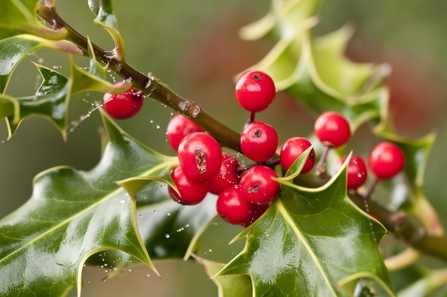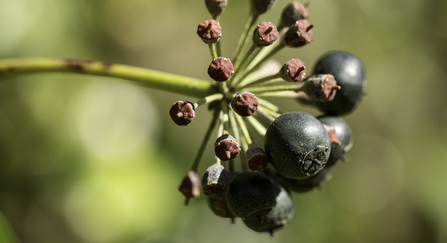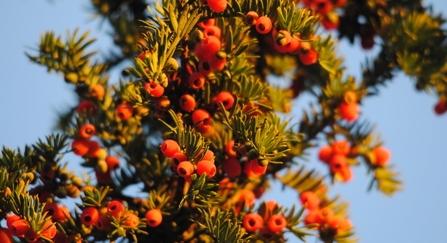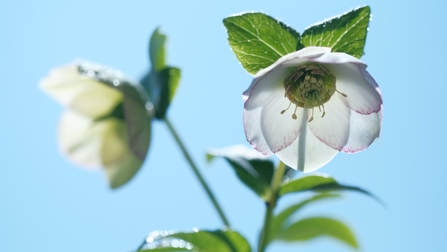
WildNet - Zsuzsanna Bird
Five Christmassy Plants
Here are some of the plants we associate with Christmas, using them to make Christmas wreathes or decorating our homes. Importantly for wildlife, they provide shelter and food during the cold winter months.
Holly
The cheery bright red berries on Holly signal that the festive season will soon be here. For wildlife, they are an important source of food. Small mammals such as wood mice and birds such a redwings and fieldfares eat the berries, giving them the energy they need to get through a long, cold winter.
Mistle thrushes have been known to guard their own berry-laden bushes with such voracity that they'll chase off any potential thieves.
As Holly retains its leaves throughout the year, it provides dense cover and good nesting opportunities for birds, while its deep, dry leaf litter may be used by hedgehogs and small mammals for hibernation. The leaves further up a holly tree, above the browsing line for deer, are smooth and in times gone by the upper branches were cut and used as fodder for livestock during the winter.

Holly (Ilex aquifolium) - Ross Hoddinott/2020Vision
Ivy
Along with holly, ivy is celebrated in many a Christmas carol. It too is evergreen, giving shelter for birds to nest and insects to hibernate. Ivy often has a bad name, accused of strangling trees. This is quite unfair as it doesn’t harm the tree, and even supports at least 50 species of wildlife.
The black, round berries of ivy have a high fat content and are said to contain nearly as many calories as Mars bars, weight for weight. Although the berries appear in November, birds such as thrushes, blackcaps, woodpigeons and blackbirds don’t tend to eat them until around Christmas. The shorter-lived berries such as rowan and hawthorn are eaten first, leaving the longer-lasting, energy-rich ivy berries until last.

Ivy (Hedera helix) berries - Chris Lawrence
Mistletoe
For us, mistletoe is a source of merriment as we kiss our sweetheart under the branches of this Christmas favourite, brought inside to decorate our homes. For thrushes, the clusters of pearlescent white berries on mistletoe are a favourite food. The aptly named mistle thrush is a fan of mistletoe berries.
The waxy berries are coated in a sticky substance which helps them to be scattered by birds. The gluey pulp around the seeds hardens and fastens the seed in place on trees such as hawthorn, poplar and lime – here in Herefordshire, cultivated apple trees are a common host.
As the new mistletoe plant grows, roots penetrate the bark and start to take water and nutrients from the tree. In winter, the clumps of mistletoe in our orchards are clearly seen and it’s often surprising how much there is. Mistletoe does weaken the tree but it’s not totally parasitic, photosynthesising from its leaves.

Mistletoe (Viscum album) - Zsuzsanna Bird
Yew
Yew trees are some of the longest living trees in northern Europe, often found in hedges, woodland understorey and churchyards, even ramparts around iron age forts as in Credenhill. Again, the green foliage of yew makes it the ideal plant for wreathes. The fleshy red fruits are called arils and are unusual in that they open at one end.
Birds, such as the blackbird, mistle thrush, song thrush and fieldfare enjoy the fruits as do small mammals, including squirrels and dormice. Although extremely poison to humans, certain compounds are extracted from the foliage of English yew (taxus baccata) and used as anti-cancer drugs. In fact many of the drugs in use today such as aspirin, morphine and those used to treat malaria are plant derived.

Yew (Taxus baccata) - Amy Lewis
Winter Honeysuckle
Though not a native wildflower, winter honeysuckle is a great plant for winter gardens. It blooms and produces nectar when most other plants are dormant. The creamy white tubular flowers are strongly scented and provide bees and hoverflies with a welcome source of nectar on warmer, winter days.
Other winter flowering plants to consider in the garden are Christmas rose (Helleborus niger), heather (Erica carnia), wintersweet (Chimonanthus praecox) and mahonia x media. The bees will be very grateful for the much needed nectar they provide.

Christmas rose (helleborus niger) - 8kka ame
